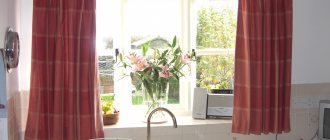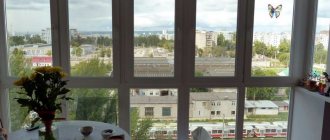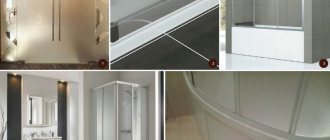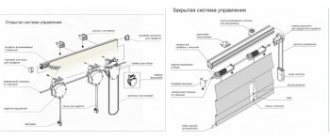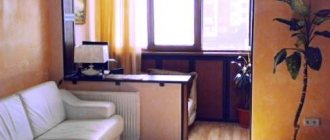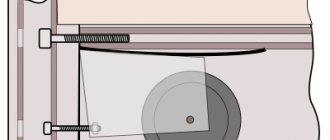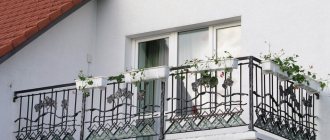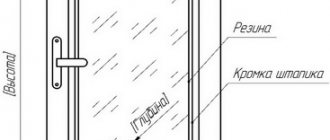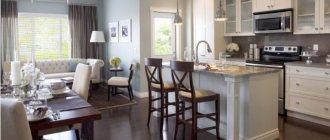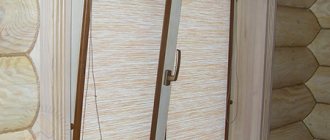Are you going to contact a company that does glazing of balconies, but you are not yet sure what exactly you need and how to answer the manager’s question “what kind of glazing would you like”? This is not surprising, because double-glazed windows and frames for them are produced in different types and in different combinations.
Let's try to understand all this diversity together. We will look at the main types of glazing, the advantages and disadvantages of different profiles, types of structures, and also touch on the issue of the legality of balcony glazing and the documents required for this.
Choice of glazing technology
The very first question you need to ask yourself when choosing glazing is cold or warm? If the balcony is supposed to be used as an additional room, kitchen, etc., then warm glazing is necessary. If it is just a utility room, a simple cold one will suffice. And these two types differ in the number of cameras in the double-glazed window.
Cold glazing
This is the most inexpensive method, and besides, frames with such double-glazed windows will weigh relatively little, which makes it possible to place them on a slab with a small load capacity. These circumstances make such glazing of balconies quite popular. The low weight of the structure is explained by the fact that the double-glazed window installed here is a single-chamber one - this can be seen in the photo.
Glazing of balconies.
Photo of a single-chamber double-glazed window Important: cold glazing of balconies and loggias has one drawback - low, relative to warm glazing, sound insulation. So think about it: if your apartment is located next to a busy highway, maybe it’s worth investing in double glazing?
Warm glazing
Warm glazing of balconies is a more expensive technology than the cold option. However, this is fully justified by excellent heat and sound insulation. A balcony or loggia with warm double-glazed windows becomes suitable even for living in them - it is enough to install heating there for the winter period. And if they are combined with a room, then perhaps installing additional heating will not be necessary.
The heat and sound insulating qualities of winter glazing are ensured by the presence of two chambers in the double-glazed window - in the photo below there is an example of just this format. But do not forget that the more cameras, the greater the weight of the entire glazing. Therefore, before installing such double-glazed windows on the balcony, it is worth checking the condition of its supporting slab.
Warm glazing of balconies
Sliding plastic windows and profile type
For the production of windows, 2 types of profiles are used: PVC and aluminum. Each of them has its own advantages.
Aluminum sliding windows
Due to their lack of tightness, they are not recommended for use where a high level of thermal insulation is required. Alkaline seals provide good protection against street dust and dirt, but do not protect against the penetration of cold air. Basically, aluminum sliding windows are installed on large balconies where maintaining high temperatures in winter is not required.
There are aluminum windows with increased tightness, but due to their considerable cost they are used extremely rarely.
Advantages of aluminum structures:
- light weight;
- increased strength;
- thin frames transmit light well;
- ideal for external glazing;
- able to withstand increased load.
Sliding glazing of balconies with PVC profile
If warm sliding windows are required, then it is recommended to use a PVC profile, which, in combination with energy-saving double-glazed windows, allows heat loss to be reduced to the minimum possible.
Advantages of PVC sliding windows:
- possibility of installing special anti-burglary fittings;
- increased tightness, previously provided for when creating the structure;
- low cost.
The main disadvantage of the PVC profile is its rather high weight, as a result of which it cannot be used for external glazing.
PVC, aluminum or wood?
Now let's decide what kind of frames we need: PVC, aluminum or wood? They are all suitable for both warm and cold glazing, but the thermal performance indicators will be different for everyone.
Aluminum profile
Glazing of balconies with aluminum profiles has been gaining popularity in recent years. This is not surprising. This material is inexpensive, durable, resistant to thermal, chemical influences and ultraviolet radiation. It is possible to manufacture structures from aluminum to suit the most demanding requests - in color, shape and price. This is a good economical option.
Cold aluminum glazing of the balcony is excellent. The frame is light, thin, but at the same time quite durable. In the photo below - it’s a cold design - the frame itself consists of one chamber. If the load-bearing capacity of the load-bearing slab of your balcony is not high, or the glazing is carried out, then aluminum will be a good solution.
And now about the disadvantages of this profile:
- Low thermal protection compared to other materials.
- Possibility of frosting of the door opening mechanism in winter.
- Low sound insulation in some cases, for example, in sliding structures.
Glazing of balconies with aluminum: frame without decorative coating
PVC structures
Glazing of balconies with plastic windows has been known to Russians for a long time and has become commonplace, but is not losing its position in the market. This is due to the fact that PVC windows have several important qualities:
- Good thermal insulation qualities.
- High noise protection.
- Light weight. Warm glazing made of plastic will weigh less than a similar one made of wood or metal-plastic.
If we talk about the minuses, there are only two of them:
- A cracked or deeply scratched plastic frame cannot be repaired and will have to be replaced. But aluminum, for example, is not subject to cracks.
- When burned, plastic releases toxic gases. Wooden frames, which we will discuss below, are safer in this regard.
Plastic balconies: cross-sectional photo of the frame
Wooden frames
Many people consider glazing balconies with wooden frames to be archaic and outdated. And in vain, because wood is an environmentally friendly material that retains heat well. Another point that not everyone knows about: the glazing of balconies with wood is chamber-like, just like when using plastic or aluminum. In addition, wood, unlike plastic, is less susceptible to temperature fluctuations.
Wooden frames can be used on balconies and loggias of any type, if there are no weight restrictions. With proper care, the structure will last quite a long time, although less than those mentioned above. There are only two disadvantages to wooden frames, one of them is controversial: wood is inferior to plastic in terms of tightness. And this minus is controversial because the complete tightness of PVC sometimes leads to fogging of the glass and high humidity in the room, which happens less often with wood. The second disadvantage is the need for constant monitoring of the paintwork from the inside and outside.
This is what a wooden frame looks like in section
What are the advantages of aluminum profile?
- Let us note one of the most significant advantages of aluminum profiles - affordable, affordable cost . Sometimes this factor is decisive. Compared to a PVC profile: the cost of installing one PVC profile allows you to install two aluminum profiles. Moreover, the quality and functionality of the aluminum version are practically not inferior. Even if the budget allocated for repairs is modest, the cost of an aluminum profile allows you to change and refresh the look of the balcony at an affordable price.
- An important property of an aluminum profile is its low weight . The lightness of the profile becomes the most significant advantage for residents of old and dilapidated houses - in such houses there is often a ban on exceeding the load on the building structure. Lightweight aluminum profile does not create additional load. In comparison with a frame made of PVC or wood, which differ in significant weight, an aluminum profile can be mounted on a metal parapet - it will not support the weight of heavy window structures.
- The advantage of an aluminum profile is its sound insulation properties . This profile will protect you from street noise - especially if you live on the ground floor and the windows overlook a busy street. Street dust, dirt, and moisture from precipitation will not get into the room - the ability to protect against the negative influences of the outside world is no different from an aluminum profile from expensive profiles.
- The properties of the sound insulator allow you to isolate yourself from the outside world, enjoy the silence and warmth of home comfort. Aluminum profiles are durable - proper installation allows you to be confident in the reliability and strength of the glazing for many years. Experts note that, according to minimal estimates, such a profile will last about 70-80 years.
- The aluminum profile is endowed with protective functions - you will not be afraid of the frame catching fire due to a carelessly thrown cigarette butt from the upper floors. Thus, the balcony will be protected from fire .
- The customer can order a special mosquito net - it will protect you from insects in the summer. Structurally, the mosquito net is installed in the opening and moves on special rollers. At the same time, the grid performs its functions and does not take up much space.
- The aluminum profile is characterized by ergonomics - this property is provided by sliding systems. This allows you to save space on the balcony , provides convenient cleaning and washing of windows, and ventilation. Sliding frames are easy to use - this has been noted by many users of aluminum profiles.
Types of structures used for glazing
By choosing the type of double-glazed windows and material for the frames, you will have to decide whether you will install a sliding structure or a hinged one. Let's see what they are.
Sliding frames
First of all, it is necessary to note the ease of using them on small balconies. Hinged frames, familiar to all of us, when open, albeit a little, “eat up” space. If the width of your balcony is 80 cm, then a sash protruding even 20 cm will cause a noticeable inconvenience. Therefore, “sliding” balconies sometimes become a salvation.
The sliding system is quite reliable; for example, there will be no sagging of the frames, as in the swing version. Problems can only arise in cold weather: when ice freezes on the runners, the movement of the shutters can be difficult. But to avoid this, it is enough to take care of the canopy over the balcony and try not to open the windows during snowfall. Another drawback is that sliding structures today are made mostly of aluminum, they can be cold because of this.
How to glaze a balcony: sliding design
Swing frames
The swing mechanism is familiar to us all and is more familiar than the sliding-sliding mechanism. Previously, these were simple frames on two hinges, opening in one plane. Today the device has become more complicated, and in addition to ordinary plowing, we also have access to the so-called “slit ventilation” - you see it on the right side of the picture.
Hinged windows close tighter than sliding windows and are therefore more energy efficient. They are the best choice for warm glazing. The safety of the swing structure should not be ignored. Such windows are quite difficult to break open from the outside, while sliding windows can sometimes simply be pushed inward. This is worth paying attention to for those who live on the first floors.
Important: do not leave swing frames in the “slot ventilation” position unattended if there are cats in the house. The animal may try to exit through the gap and will most likely get stuck. Being in a pinched position for several hours can be critical for the body.
Wooden frame with swing opening mechanism
Finnish glazing
The system is similar to sliding glazing, since the sashes also move on runners. But with a sliding door we open only one door at a time, while the Finnish system allows you to open several at once. Thus, up to 80% of the entire opening can be opened. In addition, the profile for the Finnish system is thin, so the design is only suitable for cold glazing of balconies.
Loggia with Finnish glazing
Frameless system
Frameless glazing of balconies is often confused with Finnish. In fact, the similarity is only external; the system for opening and closing the doors is completely different; in terms of functionality, it is closer to a hinged door. The frameless design looks very modern and unusual. True, frameless glazing has a significant disadvantage for our strip - it does not protect the room from the cold at all. If you are interested in how to do frameless glazing of balconies with your own hands, the video can be found on the Internet.
Frameless glazing system
Warm glazing SPK from PVC profile
Many people prefer more comfortable conditions and glaze their loggias and balconies with warm SPC from PVC profiles and make warm interior decoration with insulation of the wall, floor, ceiling, provide lighting and equip the loggia and balcony to suit their needs.
Warm glazing SPK from PVC profile
Ours uses two options for glazing with warm SPK from PVC profiles
- Tilt and turn glazing of SPC sashes from PVC profile
- Tilt-and-slide system for opening sashes SPK from PVC profile
The first option for glazing loggias and balconies “Turn and tilt sash” SPK from PVC profile is the most common and frequently used option
PVC Profile SPC and Tilt and Turn Sash
When glazing loggias and balconies, ours uses high- and budget-class PVC profiles, which have proven themselves to be positive in the St. Petersburg weather environment.
We provide a guarantee of 6 to 10 years for the used PVC profiles REHAU, VEKA, REACHMONT.
When glazing a SPC from a PVC profile using tilt-and-turn sashes, there are minor disadvantages:
- The open sash covers the free space and blocks the passage to the loggia and balcony.
- An open or tilted sash during drafts can damage the blind part of the frame and cause mechanical damage to the fittings (additional installation of limiters for opening and closing the sash is required)
The ventilation comb can be used as a limiter for arbitrary opening and closing of the sash in wind and draft.
I would also like to say about the positive properties of SPK made from PVC profiles:
- 100% heat and noise insulation
- Resistance to aggressive environmental factors
- Aesthetic appearance, both outside and inside the loggia and balcony
- Long service life
- Minimal care and ease of maintenance
- Can be painted, laminated (large selection of RAL colors, lamination)
Acceptable technical dimensions for the manufacture of SPK from PVC profiles, which are subject to warranty:
- Sash width no more than 800 mm
- The aspect ratio of the glass unit does not exceed 1:5
- Sash height no more than 2250 mm
- Presence of impost on the doors
The second option is more expensive, but also interesting for its functional data.
These are the so-called SPK made of PVC profile “Tilt-sliding window systems” (portal)
Tilt-sliding window systems" (portal)
This is a new design, which is increasingly used for glazing loggias and balconies and has no competitors in its class.
“Tilt-sliding window system” (portal) has a large number of positive qualities:
- 100% heat and noise insulation
- Suitable for all types of loggias and balconies
- Minimal care and ease of maintenance
- Long service life
- The design looks aesthetically pleasing both outside and inside the loggia and balcony
- Can be painted and laminated (large selection of RAL colors, laminations)
- Increased light opening
- The open sash does not take up free space and does not interfere with the passage
Scheme of glazing of a loggia and balcony “Tilt-sliding window systems” (portal)
If there are side sashes, you can make an SPC from a PVC profile, a swing-and-turn sash, or make a blind one with a double-glazed window or a sandwich panel.
Permissible overall dimensions along the rebate of the sash for SPC made of PVC profiles of the “tilt sliding window system” (portal)
- Sash width from 620 mm to 1650 mm
- Sash height from 670 mm to 2400 mm
WE OFFER YOU TO CHOOSE a “Tilt sliding system” (portal) from the line of PVC profiles:
- REHAU (60 mm – 70 mm) RotoPatio fittings
- VEKA (60 mm – 70 mm) fittings MACO, GU, Vorne
Economy class PVC profile:
- IVAPER (62 mm – 70 mm) RotoPatio fittings
- REACHMONT (60 mm) RotoPatio fittings
An alternative option to “Tilted sliding window systems” (portals) is the parallel sliding system SLIDORS, in which the sashes move parallel to each other, similar to the design of a sliding wardrobe (there are no inclined sashes).
You can get acquainted with the parallel sliding system made of PVC profile SLIDORS by clicking on the links below.
If you are interested in exterior and interior decoration, insulation of loggias and balconies. Follow the link below.
About the legal side of the issue
Balcony glazing, primary or simply replacing old glazing with new one, requires documentation. Of course, you can, for example, glaze a balcony in a Khrushchev-era building without decorating it. But this turns out to be a kind of “powder keg”. One statement per live. inspection from a “caring” neighbor, and you may get some problems.
We prepare documents
In general, the requirements for paperwork may differ in different regions, so before getting started, it is better to find out what will be correct for your city. Basic instructions for collecting the necessary papers are also given here.
- From the company that will work on your balcony, take a project drawing of the future glazing. With this sheet you go to the BTI, they must issue a conclusion indicating that work on this project is possible.
- Now the Architectural and Planning Department. This organization must approve changes to the facade of the house. The APU may not be satisfied with the material you have chosen for the outer cladding. In this case, be prepared for the fact that the project will have to be redone. Also, the APU may not “like” remote glazing.
- Next we go to ROGPN - in other words, fire supervision. They must evaluate how well the structure you are going to build complies with fire safety standards.
- SES – does the premises comply with sanitary standards and functional purpose.
- DEZ - here you need to obtain a document confirming that your design will not interfere with the current operation of the house.
- District vein. Inspection. We go there with all the papers received from the above organizations. It may be necessary to carry out an examination of the project, since it was carried out by a private owner, to confirm compliance with SNiP and operational standards.
- The last authority is the MVK, here you will receive permission to begin work legally. By the way, MVK has simplified the issuance of glazing permits for houses of the following series: P55M, P44T, P3M, P46M and Pd4.
If such trips to authorities are not to your taste, or you simply do not have enough free time, then you can contact a company that provides paperwork services.
Why is glazing necessary?
There are several main reasons why apartment owners decide to improve their balcony in this way. Here are the main ones:
- insulation of the loggia;
- increasing the balcony area;
- arrangement of a new room.
The main task of glazing loggias with plastic windows using the method shown in the photo is thermal insulation of the entire apartment. Balconies protected from the cold cope well with this task, forming a kind of additional layer between the room and the street. Insulation plays a particularly important role in the cold season - then you can best feel how effective plastic profiles are. After all, everyone wants to have a warm balcony in winter.
Glazing also performs another important function. If you use high-quality materials with improved thermal insulation characteristics, you can remove the ceilings between the room and the loggia, thus expanding the room, as shown in the photo. In the case of a loggia, this will be easier to do, since it itself looks like a room.
If the area is large enough, then the floors may not need to be removed. As a result of glazing with plastic windows, you will get another room that can be used as a study on the loggia, a children's playroom or other room - it all depends on the wishes of the apartment owner.
